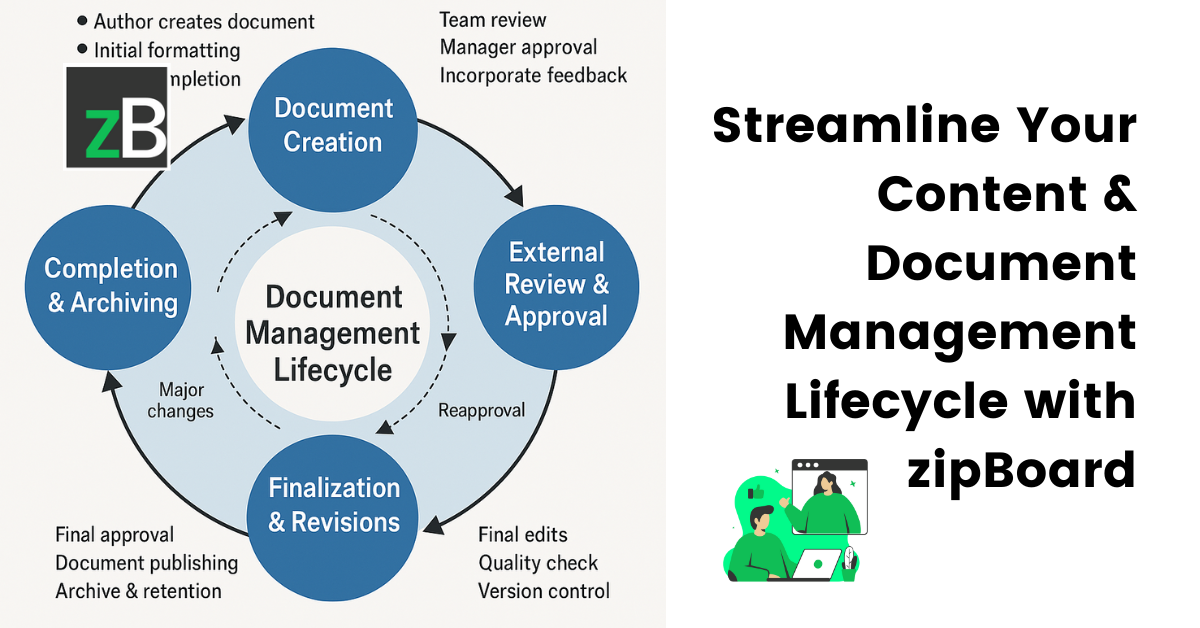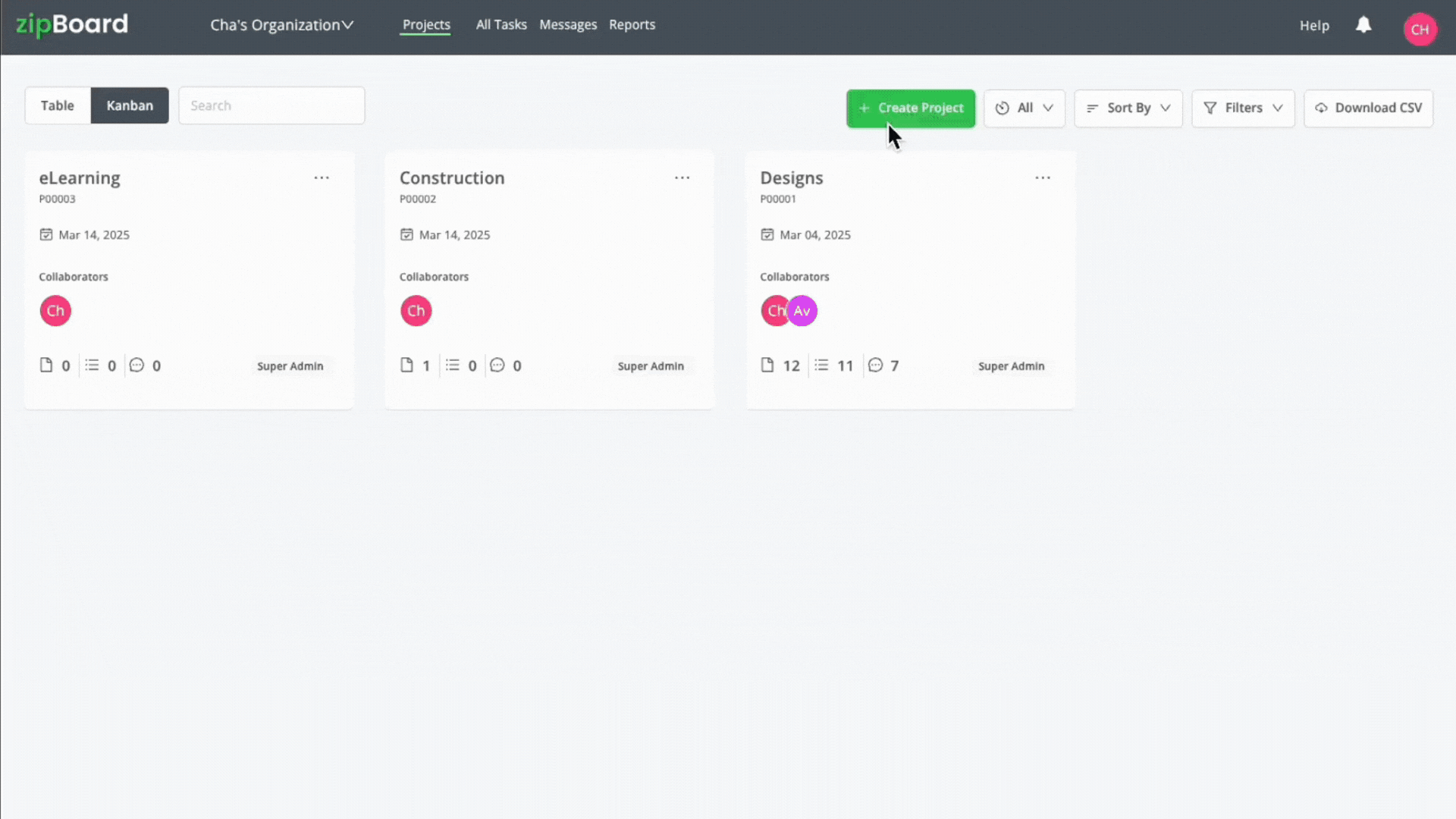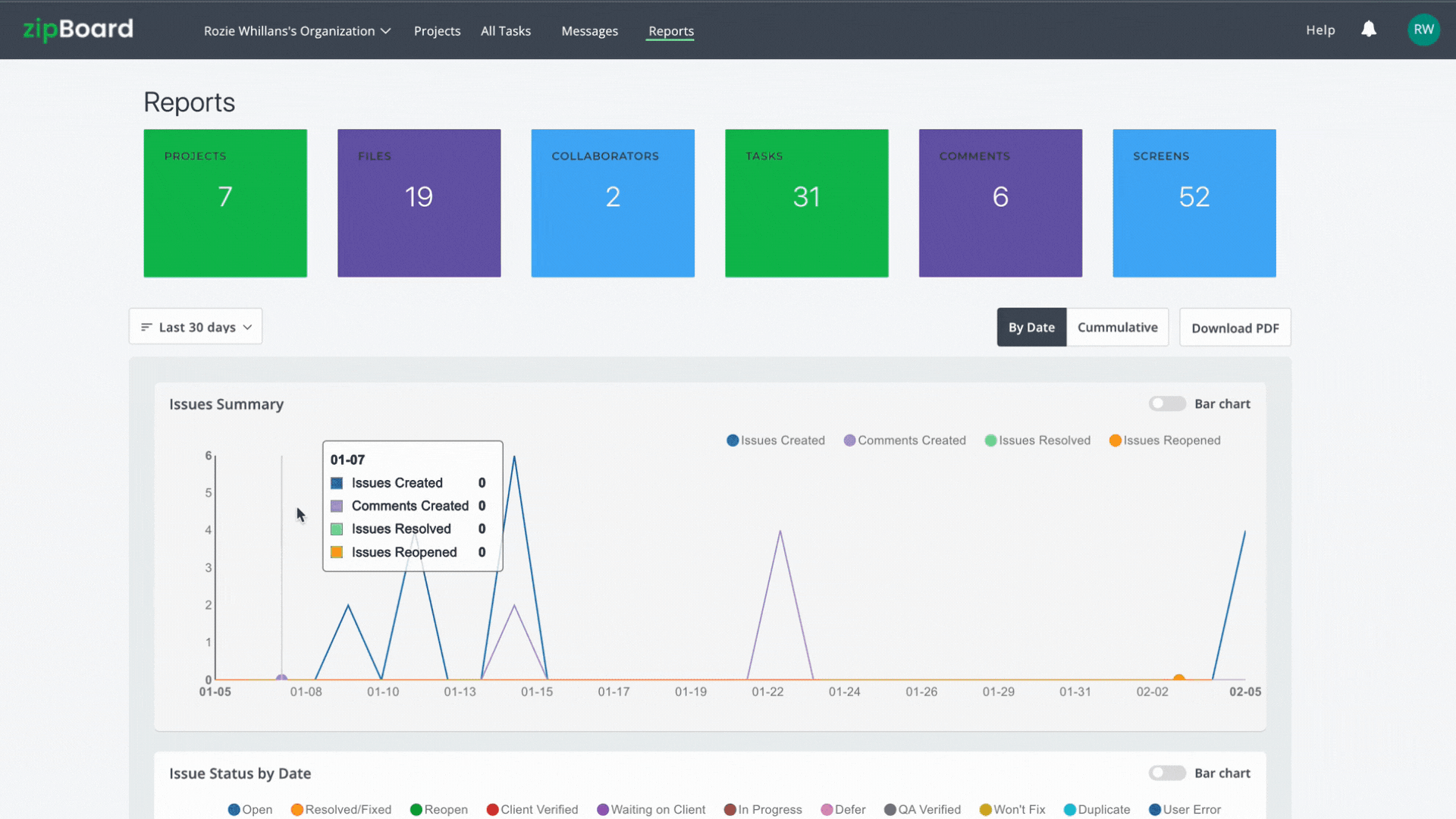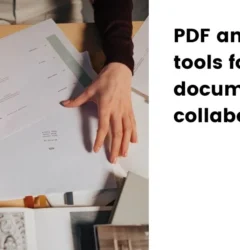Streamline Your Content & Document Management Lifecycle with zipBoard
04 Apr

Table of Contents
ToggleManaging the document lifecycle efficiently is a challenge for many teams. According to a 2024 AIIM report, organizations estimate that 67% of their unstructured data resides in cloud storage—yet only 4% report any reduction in management costs. As AI and automation initiatives accelerate, unstructured content continues to pose significant challenges, particularly around security, compliance, and workflow efficiency.
Without a structured approach, teams face version control issues, miscommunication, and bottlenecks that stall collaboration. So how can organizations ensure a seamless document management lifecycle from creation to final approval and archiving?
That’s where zipBoard comes in. zipBoard is a centralized document review and approval platform designed to simplify workflows, enhance collaboration, and keep your team aligned every step of the way.
What Is the Document Management Lifecycle? (And Why It Matters for Content Teams)
Managing content and documents effectively requires more than just storing files—it demands a structured document management lifecycle that ensures seamless collaboration, version control, and approvals at every stage.
Why does this matter? Because when content teams don’t have a clear process in place, they face miscommunication, missed deadlines, and compliance risks. This not only affects productivity but can also damage client relationships and lead to costly rework.
The document management lifecycle refers to the entire journey a document goes through—from creation and review to approval and archiving. When each phase is defined and streamlined, teams work faster, stay aligned, and deliver higher-quality content with fewer headaches.
Yet many teams still struggle to manage this process effectively. Common challenges include:
- Version Control Issues: Managing multiple file versions without a centralized system leads to confusion and errors.
- Stakeholder Coordination: Without clear workflows, getting timely feedback and approvals becomes chaotic.
- Approval Bottlenecks: Lack of visibility into who has reviewed and who still needs to approve can delay projects.
- Scattered Feedback: Reviewing content across emails, PDFs, and different platforms makes tracking changes difficult.
zipBoard simplifies document lifecycle management by providing a centralized platform for tracking reviews, approvals, and feedback. With features like review tracking, custom phases, and version control, teams can stay organized and move documents efficiently through each stage.
Streamline your document management lifecycle with zipBoard
Start your free trial or book a demo today so that we can create a tailored solution for you.
Start Free TrialBook DemoThe 5 Key Phases of the Document Management Lifecycle
A well-structured document management lifecycle ensures that content moves seamlessly from creation to completion without unnecessary delays or miscommunication.
Each phase plays a crucial role in maintaining workflow efficiency, enabling collaboration, and ensuring documents are properly reviewed and approved before archiving.
1. Creation
This is the starting point of the lifecycle, where documents, assets, or projects are created and uploaded. Teams outline objectives, set up templates, and establish initial requirements before moving into the review process.
2. Internal Review
Once a document is created, internal teams collaborate to refine it. Feedback is gathered, revisions are made, and version control best practices ensure that everyone is working on the most up-to-date version.
3. External Review & Approval
At this stage, documents are shared with external stakeholders, such as clients, partners, or compliance teams. Document approval workflows ensure that necessary feedback is incorporated while maintaining visibility into pending reviews.
4. Finalization & Revisions
After receiving approvals, final edits and revisions are made. This ensures that the document is polished and ready for use. Clear version tracking prevents outdated files from being mistakenly used.
5. Completion & Archiving
Once finalized, the document is either published, shared, or stored for future reference. Archiving ensures compliance with organizational policies and makes past documents accessible when needed.
Managing these five phases manually can lead to inefficiencies, delays, and misplaced feedback. So zipBoard simplifies this process by:
- Providing a centralized platform where teams can collaborate in real time.
- Enabling custom workflows that match different document review and approval needs.
- Offering review tracking to keep all stakeholders on the same page.
- Maintaining document version control to prevent confusion over document updates.
Recommended Reading: What Is Content Operations? And Why It Breaks Without a Feedback & Approval System
Manage your document reviews and approvals efficiently with zipBoard.
Start your free trial or book a demo today so that we can create a tailored solution for you.
Start Free TrialBook DemoWho Needs Document Management Lifecycle Software?
Effective document lifecycle management is essential for teams that handle frequent content creation, revisions, and approvals. Here are the key roles that benefit from document management lifecycle software:
- Project Managers: Oversee document progression, assign tasks, and ensure deadlines are met.
- Content Managers: Manage content creation, version control, and approval workflows.
- Legal & Compliance Teams: Ensure documents meet regulatory requirements before finalization.
- External Stakeholders: Provide critical feedback and approvals, including subject matter experts (SMEs) and clients.
- Creative & Technical Teams: Develop, update, and refine content based on review insights.
Having a dedicated platform like zipBoard streamlines collaboration between these roles, ensuring that every stage of the document lifecycle is efficient and well-organized.
Enhance your document management process—Try zipBoard today!
Start your free trial or book a demo today so that we can create a tailored solution for you.
Start Free TrialBook DemoHow zipBoard Streamlines the Document Management Lifecycle & Enables Structured Content & Document Reviews
Customizable Project Phases for Document Lifecycle
Every organization has a unique document workflow, and zipBoard allows teams to define custom phases that align with their specific needs. Whether your process includes Draft → Internal Review → External Approval → Final Sign-off → Completion, you can tailor each stage to fit seamlessly into your document lifecycle.
With Kanban boards, your team gains a visual representation of document progress, making it easy to track where each file stands and what actions are needed next.
This structured approach eliminates guesswork, reduces delays, and ensures a smooth transition from creation to completion.
Review Tracking for Complete Lifecycle Visibility
Keeping track of document reviews can be challenging, especially when multiple stakeholders are involved. With Review Tracking in zipBoard, your team gets complete visibility into the status of each document—who has reviewed, who is pending, and what approvals have been made.
This automated and structured tracking ensures that no steps are overlooked, eliminating bottlenecks and keeping projects moving forward efficiently.
By centralizing feedback and approvals, your team can streamline its workflows and ensure timely document progression.
Real-Time Collaboration Across the Lifecycle
Effective document management requires seamless collaboration at every stage. With real-time collaboration in zipBoard, teams can provide instant feedback, streamline revisions, and ensure that everyone stays aligned.
By centralizing feedback in one platform, zipBoard eliminates scattered comments across emails and multiple tools, making it easy to track changes and maintain a clear revision history.
This ensures that every stakeholder stays informed and projects move forward without delays.
Version Control & Audit Trail Across All Phases
Managing documents through their lifecycle often involves numerous revisions and approvals. With version control in zipBoard, you can easily track each document’s changes, ensuring that the latest version is always accessible to the team. This eliminates confusion and prevents the risk of working on outdated versions.
Moreover, zipBoard maintains a comprehensive audit trail for every document, documenting each revision, approval, and change. This feature is essential for compliance, providing a clear record of who made what changes and when, ensuring your team is always aligned with the latest updates.
Project Templates for Streamlined Lifecycle Management
One of the biggest time-savers in managing documents across their lifecycle is the use of project templates. In zipBoard, you can use standardized templates and customize them for your industry, ensuring that each document follows the same consistent process.
Templates streamline workflows by providing predefined steps, approval processes, and relevant stakeholder assignments, making it easier for teams to follow the same structure for recurring projects.
By reducing the need to manually set up workflows every time, templates allow your team to stay focused on the task at hand while maintaining efficiency and consistency across all phases of the lifecycle.

The Role of AI in Enhancing the Content & Document Management Lifecycle
Artificial Intelligence (AI) plays a pivotal role in enhancing the efficiency and accuracy of document management. With AI-powered features, zipBoard streamlines multiple stages of the document lifecycle, from creation to final approval. Key AI-driven capabilities include:
AI-Driven Feedback Management & Task Conversion
In zipBoard, AI automatically converts comments, feedback, or annotations into tasks.
Feedback from external reviewers is added to a separate table for managers to review, while internal reviewer feedback is directly placed in the task manager.
External tasks can later be added to the task manager if necessary, streamlining feedback processing and improving workflow efficiency.
Auto-Generated Reports
zipBoard automatically generates comprehensive reports based on document activity and feedback, saving time and reducing manual effort. These reports are critical for tracking progress, identifying bottlenecks, and ensuring that deadlines are met.

Auto-Tagging Files & Tasks
zipBoard’s AI can automatically tag files and tasks based on content, keywords, or context. This helps categorize and organize documents more effectively, making it easier for teams to locate and prioritize work.
By automating routine tasks and ensuring the right processes are followed at each stage, AI significantly improves the management of documents, leading to quicker feedback cycles, better collaboration, and a more streamlined document lifecycle process.
Why Use zipBoard for Document Lifecycle Management?
zipBoard offers a comprehensive platform designed to streamline document review and approval processes, providing significant benefits to teams and organizations:
Efficient Review & Approval Process
From document review to final approval, zipBoard simplifies collaboration and feedback collection, ensuring teams can effectively manage each phase of the document lifecycle.
With real-time annotations, task assignments, and version control, zipBoard ensures that the review process is organized, transparent, and efficient, so no stage is overlooked and all feedback is properly tracked.
Custom Workflows & Templates
Tailor workflows and project templates to your specific needs, ensuring that every document moves smoothly through its lifecycle. This flexibility helps organizations avoid inefficiencies and maintain consistency across multiple projects.
Enhanced Collaboration
With real-time collaboration features, zipBoard allows internal and external stakeholders to work together seamlessly. This improves the speed of reviews, reduces back-and-forth emails, and ensures timely feedback for faster decision-making.
Full Visibility & Review Tracking
Stay on top of your document’s progress at every stage. zipBoard provides full visibility of the review and approval process, ensuring that nothing is missed and that documents move forward efficiently.
Version Control & Audit Trail
Maintain a clear, documented history of all revisions, approvals, and feedback. With version control and an audit trail, teams can easily track changes and ensure that they are always working with the latest document version.
Transform your document management lifecycle—Sign up for a free trial today!
Start your free trial or book a demo today so that we can create a tailored solution for you.
Start Free TrialBook DemoStreamline Your Content & Document Management Lifecycle with zipBoard
Managing the entire document lifecycle doesn’t have to be complicated. With zipBoard, you can effortlessly handle every phase—from creation to final completion and archiving. By simplifying each stage with customizable workflows, real-time collaboration tools, review tracking, and version control, zipBoard ensures smooth and efficient document management.
In addition, zipBoard’s AI-driven features take your document workflows to the next level, helping you route tasks intelligently, prioritize feedback, and maintain full visibility throughout the process. Whether you’re working on internal reviews, gathering client approvals, or ensuring compliance, zipBoard streamlines it all.
Ready to Streamline Your Review Workflows, Improve Version Control, and Collaborate Smarter?
Try zipBoard for free today and experience frictionless document management.
Start Free TrialBook DemoFAQ: Document Management Lifecycle
The document management lifecycle refers to the entire journey of a document, from its creation and review to final approval, archiving, and disposal. It ensures that documents are organized, reviewed, and stored in compliance with organizational and regulatory requirements.
Content lifecycle management is the process of managing the entire lifespan of digital content, including creation, review, approval, distribution, and archiving. It ensures that content is effectively controlled, updated, and maintained throughout its lifecycle.
zipBoard streamlines the document lifecycle by offering tools for real-time collaboration, review tracking, customizable project phases, version control, and AI-driven task routing. It ensures documents move smoothly through creation, internal reviews, client approvals, and final completion, all within a centralized platform.
The key steps of document management include:
- Creation: The document is created or uploaded.
- Review: Internal and external stakeholders provide feedback.
- Approval: The document goes through an approval workflow.
- Revisions: Changes are made based on feedback.
- Archiving: The finalized document is stored for future reference.
Document processing generally includes stages like:
- Document creation (drafting or uploading).
- Review (gathering feedback from stakeholders).
- Approval (finalizing feedback and securing approvals).
- Revisions (incorporating changes and making updates).
- Archiving (storing the final version for compliance and record-keeping).
Document lifecycle management is the process of managing a document’s journey from its creation, through various review and approval stages, until its final storage or disposal. It helps organizations ensure document compliance, security, and efficiency at every stage.
Best practices include:
- Centralized document storage to ensure easy access and version control.
- Clear workflows for review and approval stages.
- Automated task assignments to reduce manual effort.
- Version control to track document changes.
- Regular archiving and disposal based on retention policies.
Document lifecycle management software is a tool or platform designed to automate, track, and manage the entire lifecycle of a document. It ensures documents go through creation, review, approval, and storage stages smoothly and efficiently.
Recent Posts
- MEP Document Management: How to Streamline Reviews & Avoid Rework October 3, 2025
- What Is Online Proofing Software? And Why Content Review Breaks Without It July 11, 2025
- How Laerdal Medical Cut eLearning Review Time by 50% with zipBoard’s Visual Review Tool July 9, 2025
- Why Your Team Needs a Content Feedback System (Not Just Comments in Docs) May 28, 2025
- Content Approvals Are Slowing You Down — Here’s the Fix May 26, 2025
©️ Copyright 2023 zipBoard Tech. All rights reserved.


